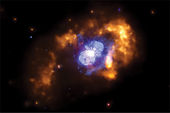
© NASAThe answer to the riddle of dark matter could be found in our own solar system
A subtle anomaly in the orbit of the planets in our solar system could prove a controversial idea that goes beyond Einstein.
The orbit of the innermost planet, Mercury, departs from what it should be under Newton's laws. A century ago, when Einstein explained this anomaly, it confirmed his theory of gravity - the general theory of relativity.
Now an Israeli physicist predicts that a similar but far more subtle anomaly in the orbits of the planets, if detected, might prove his own theory, known as modified Newtonian dynamics, or MOND. This provides an alternative theory to dark matter to explain why stars orbiting at the edge of spiral galaxies are not flung out into space. These stars are travelling at speeds too fast for conventional gravity from the mass at the heart of a spiral galaxy to hold them in their orbits, so something else must be keeping them on track.
One theory is that invisible dark matter provides that extra pull. But an alternative is MOND, devised in the early 1980s by Mordehai Milgrom, now at the Weizmann Institute of Science in Rehovot, Israel.


